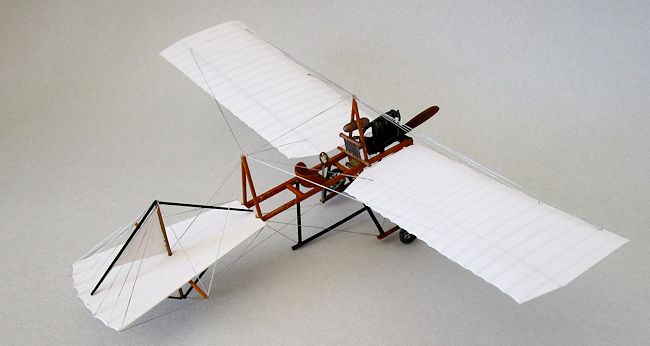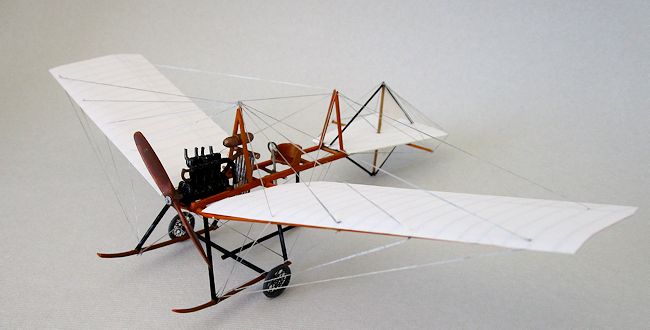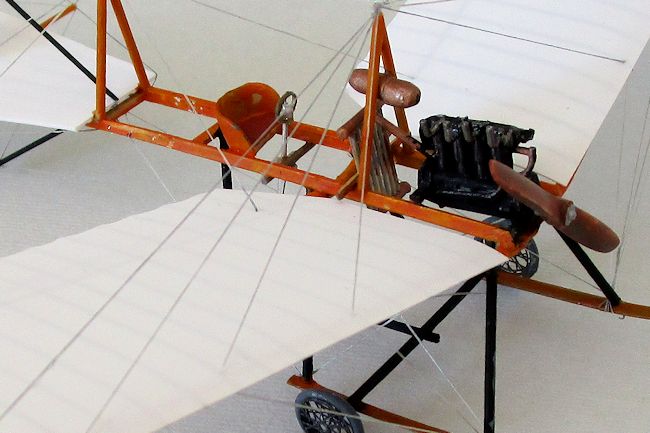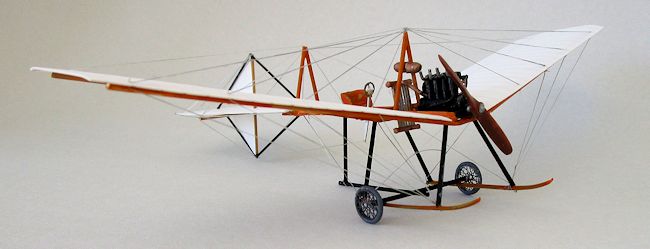
1/72 1910 Fokker Spin
| KIT #: | |
| PRICE: | $ |
| DECALS: | |
| REVIEWER: | Chris Peachment |
| NOTES: | Made from 10 and 20 thou plastic card, strut and rod. |

| HISTORY |
The Fokker Spin (sometimes known by the
German equivalent Spinne) was the first aircraft built by Anthony Fokker who
needs no introduction here. The name is Dutch for Spider, because of all the
bracing wires which look like a web. But it could justifiably be called “Six
Long Struts, Ten Short Struts and Forty Miles of Rigging”, all flying in
tight formation.
Fokker built the Spin in 1910 while still a student in Germany. It began as an experimental design to enable him to learn to fly. The first version was destroyed when it flew into a tree, but the engine was salvaged and recycled into a second version, which enabled Fokker to gain his Pilot's Licence.
 In
his third model, he gained fame in Holland by flying around the tower of a
church in Haarlem on August 31, 1911, which was the birthday of Queen Wilhelmina.
Thanks to this gallant gesture he became famous. After this he founded a
factory and school near Berlin, where he redesigned the Spin as a two seater
for the German army.
In
his third model, he gained fame in Holland by flying around the tower of a
church in Haarlem on August 31, 1911, which was the birthday of Queen Wilhelmina.
Thanks to this gallant gesture he became famous. After this he founded a
factory and school near Berlin, where he redesigned the Spin as a two seater
for the German army.
The aircraft had a 100hp Argus or Mercedes engine and a top speed of 60mph. From 1912 to 1913, a total of 25 Fokker Spins were built (including a few two-seat variants), which were mainly used for pilot training.
One of the last Spins was brought to the Netherlands after WWI, and was rebuilt in the early 1920s. In WWII, the aircraft was taken to a museum in Berlin as a war trophy by the Germans occupying the Netherlands. Since the aircraft had taught an earlier generation of pilots in the German army how to fly, the Nazis clearly lacked a sense of irony. After the war, it went first to Poland and then to the Netherlands where it was restored. A second Spin was built by Fokker staff in 1936 to commemorate the 25th anniversary of Fokker's first flight. Both of these aircraft are preserved at the Aviodrome aviation museum at Lelystad Airport, in the Netherlands.
Construction of the aircraft was very simple. The fuselage is two wooden beams with cross members on which the pilot is seated and on which the Argus four-cylinder water-cooled engine was mounted. The radiators are placed on either side of the fuselage, although there were some models which had a single radiator behind the engine. I chose to model this type. The wings and tail were two steel tubes for spars and then bamboo ribs. The landing gear was steel tubing. And the whole thing was held together by steel wire rigging.
| CONSTRUCTION |
 Plans were found on a website
below and printed out to 1/72 scale, along with as many photographs as I
could find, of which there are many of good quality. As well as the radiator
variations, there were also variations to the rear kingpost. Some were
mounted to the rear of the fuselage, and were rigged as I show. But some had
the second kingpost mounted in front of the pilot, and rigged to the wing
trailing edges. If you are feeling confident about your rigging skill, and
also masochistic, then you could try that variant.
Plans were found on a website
below and printed out to 1/72 scale, along with as many photographs as I
could find, of which there are many of good quality. As well as the radiator
variations, there were also variations to the rear kingpost. Some were
mounted to the rear of the fuselage, and were rigged as I show. But some had
the second kingpost mounted in front of the pilot, and rigged to the wing
trailing edges. If you are feeling confident about your rigging skill, and
also masochistic, then you could try that variant.
Construction began as usual with the cockpit, but since there isn't one, I skipped to step two, which is the fuselage. Two long square section struts and six short struts saw the job done. You now have the basic ladder frame on which to hang everything else. Since the wings have a marked dihedral and sweepback, I decided to leave those until last.
The engine came from an old six cylinder unit in the Bag of Dead Engines, which was cut down to size, and mounted on cross beams. Behind that came the front kingpost, made of two angled struts. Hanging under them was hung a short fuel tank, sanded from sprue and painted copper. Then behind that came a radiator, made from lengths of thin rod for the core, and two thicker rods for the header and base tank. This can be wired to the engine block using thick copper electrical wire, which, being copper, is easily pliable and has the benefit of being copper-coloured. Alas, it does not look right in this scale, being far too bright, and so I gave them a coat of copper paint, which looked much more realistic than the real thing. Convention is everything.
The row of exhaust pipes were
made from small bits of bent rod, and were added right at the end of the
build, as I knew that handling would knock them off. Moving two cross beams
back toward the tail, a small seat from the Bag of Dead Seats was mounted
for the pilot, and a control column made from scrap, with a tiny wheel on
top. Further back still came the rear kingpost, and then the horizontal
tailplane made from ten thou card, scored underneath with ruler and black
biro to represent ribs, and blasted with Humbrol white Primer from a rattle
can. The variety of outlining s truts and posts were only a matter of a few
minutes in the making and lining up. Lastly two rudders from 10 thou card
can be blitzed white and inserted.
truts and posts were only a matter of a few
minutes in the making and lining up. Lastly two rudders from 10 thou card
can be blitzed white and inserted.
Now come the wings. The two main spars were cut from thickish rod, and then judiciously bent at the right angles of dihedral and sweepback. They were then mounted onto brackets underneath the fuselage and painted wood brown. Once dry, much checking and bending is necessary to try to get them aligned at the right angles. The wing fabric was 10 thou card, cut to shape, and scored underneath with black biro to represent the pockets for the bamboo ribs. The two wings can then be glued to the spars.
Then the whole contraption can be turned upside down, and the landing gear added, strut by strut. For this I found it useful to clip the fuselage to one of those handy little items which used to sit on tables in restaurants with business cards or reservation notices attached. I don't know what they are called, but they are a short length of wire with a weighted cube at the bottom and an alligator clip at the top. I have several and they are very useful as a third hand.
The undercarriage is a straightforward set of struts and axle, but with the addition of a rear skid attached to the axle and held by a vertical strut from behind the pilot's seat. All surviving examples have these metal rods painted in black. The wire wheels came from an Eduard set of etched metal spokes, and the tyres, slightly fatter than most WWI aircraft, were made from solder wrapped around a paintbrush handle.
Now I hear a sharp intake of
breath and a drumroll which indicates it is the moment of truth. Do not
pause for any second thoughts but plunge into the rigging, armed with
elastic thread, silver felt tip pen, superglue gel applied with sharpened
toothpicks and an iron will. In no time at all you will have a true
 flying
spider web.
flying
spider web.
As a general rule, if you see the end of a strut sticking out, then rig it to the nearest appropriate point on the wing or fuselage.
For reasons of habit, the propeller is always the last thing to be added, and this was found in the big Bag of Old Props, sanded to shape, given a coat of dark wood, and some clear orange, and mounted at ten to four.
If you really want to get fancy, one of the variants had “Fokker” written under the wings, with “Fok” on one side and “ker” on the other. It was written in a highly decorative font which has been lost to history, and doesn't figure on any font site that I could find. It could be hand painted on, but while rigging holds no fears for me, my sign painting skills are rusty. So I left the Spider naked as nature intended.
| CONCLUSIONS |
There are many things to be said in favour of pre-WWI aircraft as modelling
subjects. For a start, there are very few mainstream kits available, and so what
you end up with is unique. They have the pleasing look of being very
complicated, when in fact construction is quite simple. They make a nice change
from that 23rd
Spitfire or Mustang which you were contemplating. Also, you are taking a look at
the very dawn
 of aviation, when there were no rules as to what an aircraft might
look like, and intrepid men were climbing into them with only a sketchy idea of
how to fly.
of aviation, when there were no rules as to what an aircraft might
look like, and intrepid men were climbing into them with only a sketchy idea of
how to fly.
While the Spin's layout is conventional by later standards, it has no flying instruments, and so Anthony Fokker would have taught himself to fly by gingerly coaxing it up into the air for a short hop, and then even more gingerly coaxing it down onto terra firma again. And there was no undercarriage springing to soften the blow of landing either. No wonder they used to say that a good landing was one you walked away from.
From this one aircraft sprang the Fokker Eindecker, the Triplane, the series of inter-war Trimotor airliners, the D.XXI fighters which defended Holland against the Nazis, and Finland against the communists, and the later airliner Fokker Friendship. It is, all in all, a great history in the annals of aviation, and it all began with a Spider.
| REFERENCES |
http://www.dutch-aviation.nl/index5/Civil/index5-2%20Spider%202.html
http://www.aviationgraphic.com/airplanes/928-etrich-taube-hc-09.html
http://www.airliners.net/photo/Fokker-Spin-III/0653967/L/
http://www.dbnl.org/tekst/post034avia01_01/post034avia01_01_0007.php
August 2015
If you would like your product reviewed fairly and fairly quickly, please contact the editor or see other details in the Note to Contributors.